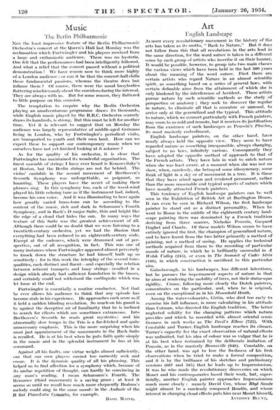Art
English Landscape
ALMOST every revolutionary movement in the history of the arts has taken as its motto, " Back to Nature." But it does not follow from this that all revolutions in the arts lead in the same direction, for the word nature is taken in a different sense by each group of artists who inscribe it on their banner.; It would be possible, howeVer, to group into two main classes the various views which have been held in the last 500 years about the meaning of the word nature. First there are certain artists who regard Nature in an almost scientifid spirit, as something based on a series of general laws, with certain definable aims from the attainment of which she is only hindered by the interference of Accident. These artists pursue nature by such scientific methods as the study .of perspective or anatomy ; they seek to discover the regular in nature, to eliminate all that is eccentric or unusual, to arrive only at the generalized and the typical. This attitude to nature, which we conneet.particularly with French painters; may seem to us cold and remote, but it receives its justification from the existence of such landscapes as Poussin's Phaeton, its most masterly embodiment.
English landscape painters, on the other hand, have nearly always held the opposite view. They seem to have regarded nature as something irresponsible, always changing, subject to no laws, infinitely various. Consequently they have adopted the opposite method of approach to that of the French artists. They have lain in wait to catch nature when she was least aware, at a moment when she was not on show, when, carelessly, she betrayed some idiosyncrasy, some freak of light in a sky or of movement in a tree. It is these that they have seized upon and rendered permanent, rather than the more reasonable and typical aspects of nature which have usually attracted French painters.
This tendency of English landscape painters can be well seen in the Exhibition of British Art at Burlington House: It can even be seen in Richard Wilson, the first landscape painter to stand out as a distinct personality. When he went to Rome in the middle of the eighteenth century land- scape painting there was dominated by a French tradition deriving from three sources, Nicholas Poussin, Gaspard Dughet and Claude. Of these models Wilson seems to have entirely ignored the first, the champion of generalized nature, and to have learnt from the two latter primarily a method of painting, not a method of seeing. He applies the technical methods acquired from them to the recording of particular moods of nature, in which he is brilliantly successful in A Welsh Valley (245), or even in The Summit of Cader Idris (186), in which construction is sacrificed to this particular
aim. .
Gainsborough, in his landscapes, has different intentions; but he pursues the impermanent aspects of nature in that he aims at rendering the mobility of trees, not their statuesque rigidity. Crome, following more closely the Dutch painters, concentrates on the particular, and, when he- is original,. even on the exceptional as in his Mousehold heath.
Among the water-colourists, Girtin, who died too early to
exercise his full influence, is more calculating in his attitude than Cotman, who directed the English tradition. The lattee neglected solidity for the changing patterns which nature provides and which he recorded with almost oriental sensi- tiveness in such works as The Devil's Elbow (725). With Constable and Turner, English landscape reaches its climax; Turner's capacity for the exact observation of natural effects was unlimited, but his idea of colour was so vulgar that he is at his best when restrained by the deliberate imitation of Poussin, as in the masterly Bonneville ((48). Constable, on- the other hand, was apt to lose the freshness of his first observations when he tried to make a formal composition,- and it is by the brilliance of his sketches and preliminary versions (687 and 585) that he leads up to Impressionism.' It was he who made the revolutionary discoveries on which Monet and his contemporaries based their work, but, super- ficially, another English painter approaches Impressionism' much more closely : namely David Cox, whose Rhyl Sands might almost be a carelessly composed Boudin, -and whose interest in changing cloud effects puts.him near Monet himself.,
AXTIIONY BLUNT.










































 Previous page
Previous page